Contemporary Practices in Nursing: Leadership and Management
VerifiedAdded on 2022/11/10
|12
|3402
|461
Report
AI Summary
This report delves into contemporary nursing practices, focusing on leadership, communication, and professional development. It begins by examining various leadership styles, including charismatic and servant leadership, and their impact on healthcare environments. The report then addresses the importance of communication skills and health informatics, emphasizing privacy, security, and confidentiality in the context of electronic health records and digital innovations like e-prescriptions and reception robots. Furthermore, it explores role conflict within nursing, discussing its causes and effects on job satisfaction and effectiveness, alongside strategies for self-care, such as progressive relaxation and reframing negative thoughts, to support nurses' well-being. The report underscores the significance of these elements in fostering a healthy work environment and delivering high-quality patient care.
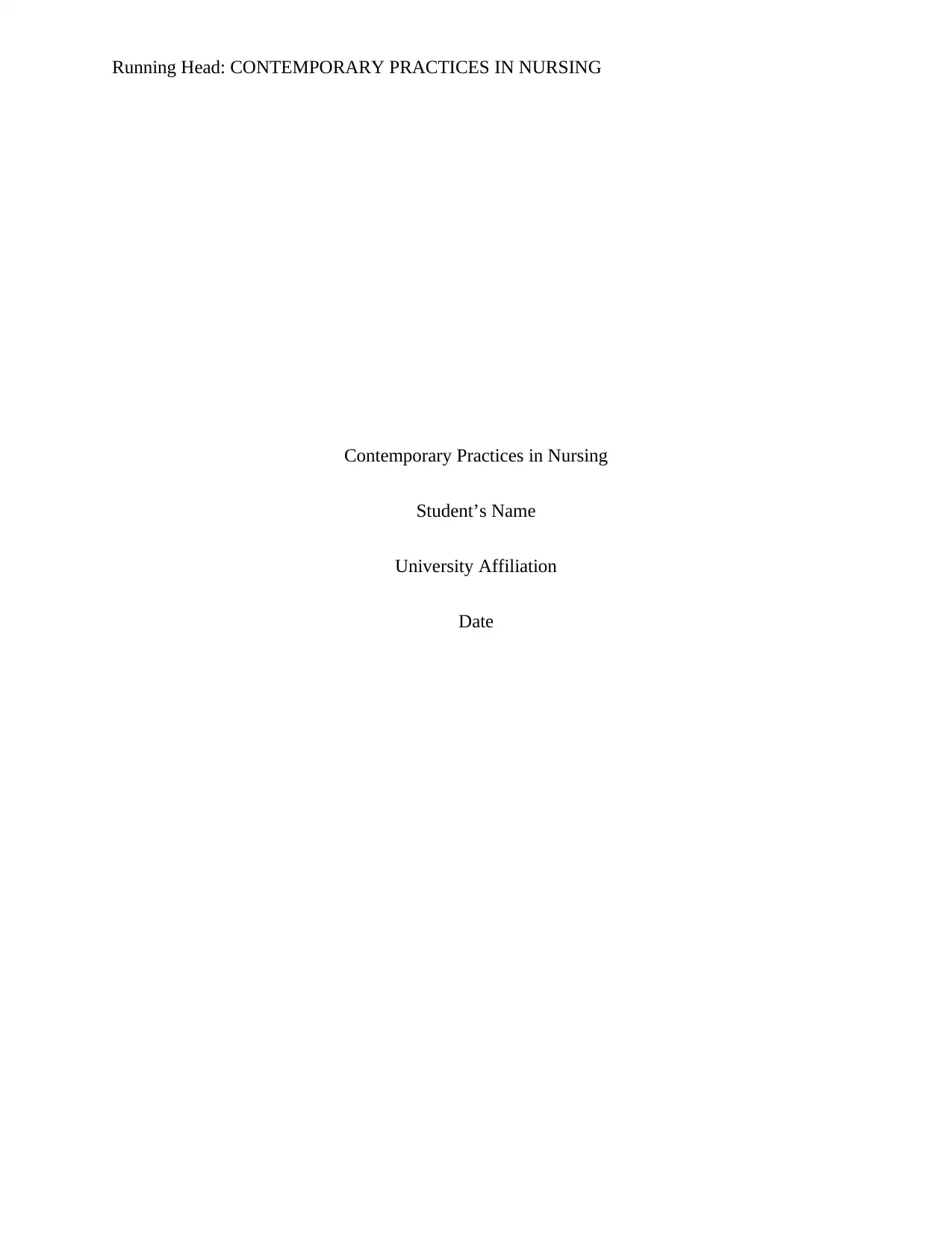
Running Head: CONTEMPORARY PRACTICES IN NURSING
Contemporary Practices in Nursing
Student’s Name
University Affiliation
Date
Contemporary Practices in Nursing
Student’s Name
University Affiliation
Date
Paraphrase This Document
Need a fresh take? Get an instant paraphrase of this document with our AI Paraphraser
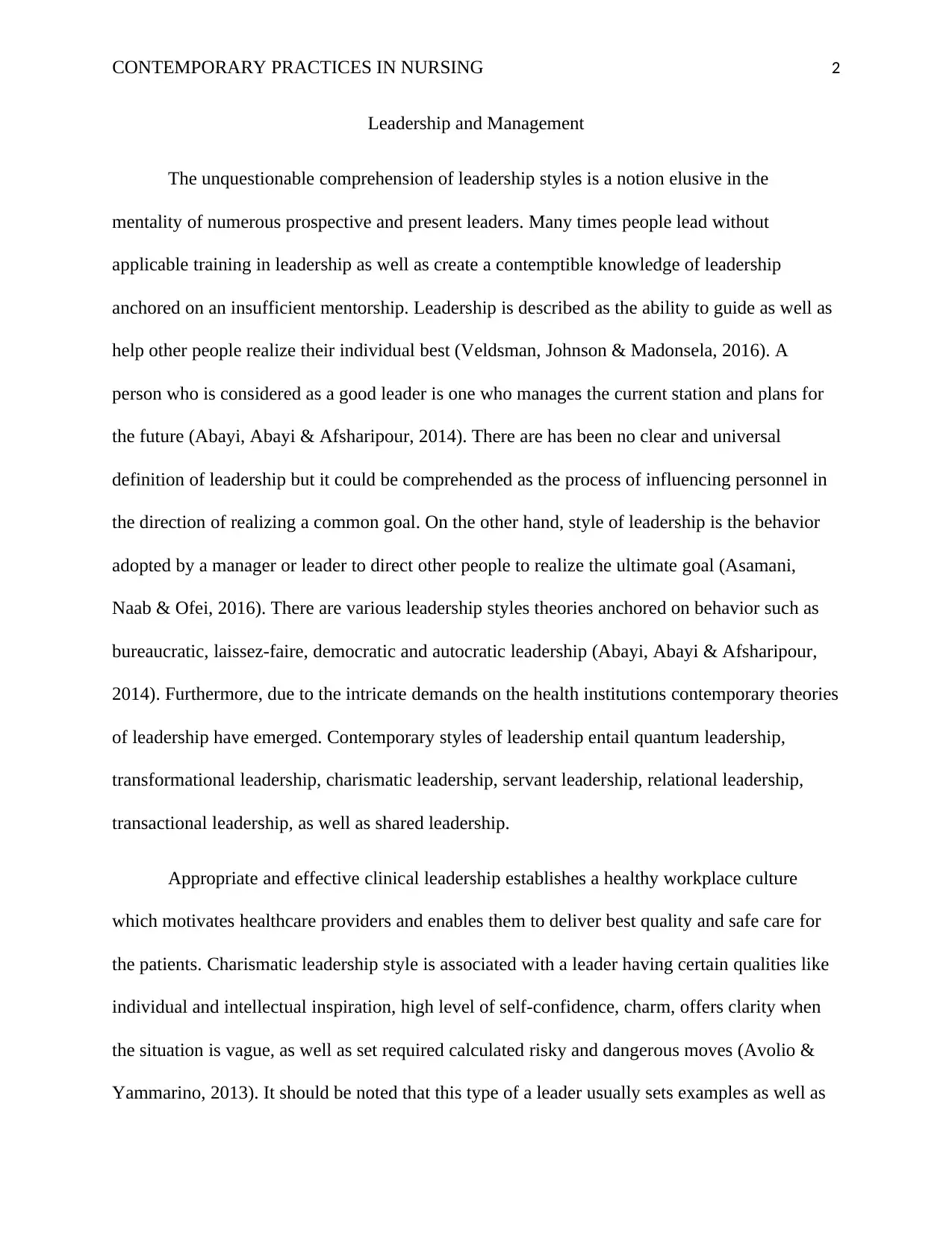
CONTEMPORARY PRACTICES IN NURSING 2
Leadership and Management
The unquestionable comprehension of leadership styles is a notion elusive in the
mentality of numerous prospective and present leaders. Many times people lead without
applicable training in leadership as well as create a contemptible knowledge of leadership
anchored on an insufficient mentorship. Leadership is described as the ability to guide as well as
help other people realize their individual best (Veldsman, Johnson & Madonsela, 2016). A
person who is considered as a good leader is one who manages the current station and plans for
the future (Abayi, Abayi & Afsharipour, 2014). There are has been no clear and universal
definition of leadership but it could be comprehended as the process of influencing personnel in
the direction of realizing a common goal. On the other hand, style of leadership is the behavior
adopted by a manager or leader to direct other people to realize the ultimate goal (Asamani,
Naab & Ofei, 2016). There are various leadership styles theories anchored on behavior such as
bureaucratic, laissez-faire, democratic and autocratic leadership (Abayi, Abayi & Afsharipour,
2014). Furthermore, due to the intricate demands on the health institutions contemporary theories
of leadership have emerged. Contemporary styles of leadership entail quantum leadership,
transformational leadership, charismatic leadership, servant leadership, relational leadership,
transactional leadership, as well as shared leadership.
Appropriate and effective clinical leadership establishes a healthy workplace culture
which motivates healthcare providers and enables them to deliver best quality and safe care for
the patients. Charismatic leadership style is associated with a leader having certain qualities like
individual and intellectual inspiration, high level of self-confidence, charm, offers clarity when
the situation is vague, as well as set required calculated risky and dangerous moves (Avolio &
Yammarino, 2013). It should be noted that this type of a leader usually sets examples as well as
Leadership and Management
The unquestionable comprehension of leadership styles is a notion elusive in the
mentality of numerous prospective and present leaders. Many times people lead without
applicable training in leadership as well as create a contemptible knowledge of leadership
anchored on an insufficient mentorship. Leadership is described as the ability to guide as well as
help other people realize their individual best (Veldsman, Johnson & Madonsela, 2016). A
person who is considered as a good leader is one who manages the current station and plans for
the future (Abayi, Abayi & Afsharipour, 2014). There are has been no clear and universal
definition of leadership but it could be comprehended as the process of influencing personnel in
the direction of realizing a common goal. On the other hand, style of leadership is the behavior
adopted by a manager or leader to direct other people to realize the ultimate goal (Asamani,
Naab & Ofei, 2016). There are various leadership styles theories anchored on behavior such as
bureaucratic, laissez-faire, democratic and autocratic leadership (Abayi, Abayi & Afsharipour,
2014). Furthermore, due to the intricate demands on the health institutions contemporary theories
of leadership have emerged. Contemporary styles of leadership entail quantum leadership,
transformational leadership, charismatic leadership, servant leadership, relational leadership,
transactional leadership, as well as shared leadership.
Appropriate and effective clinical leadership establishes a healthy workplace culture
which motivates healthcare providers and enables them to deliver best quality and safe care for
the patients. Charismatic leadership style is associated with a leader having certain qualities like
individual and intellectual inspiration, high level of self-confidence, charm, offers clarity when
the situation is vague, as well as set required calculated risky and dangerous moves (Avolio &
Yammarino, 2013). It should be noted that this type of a leader usually sets examples as well as
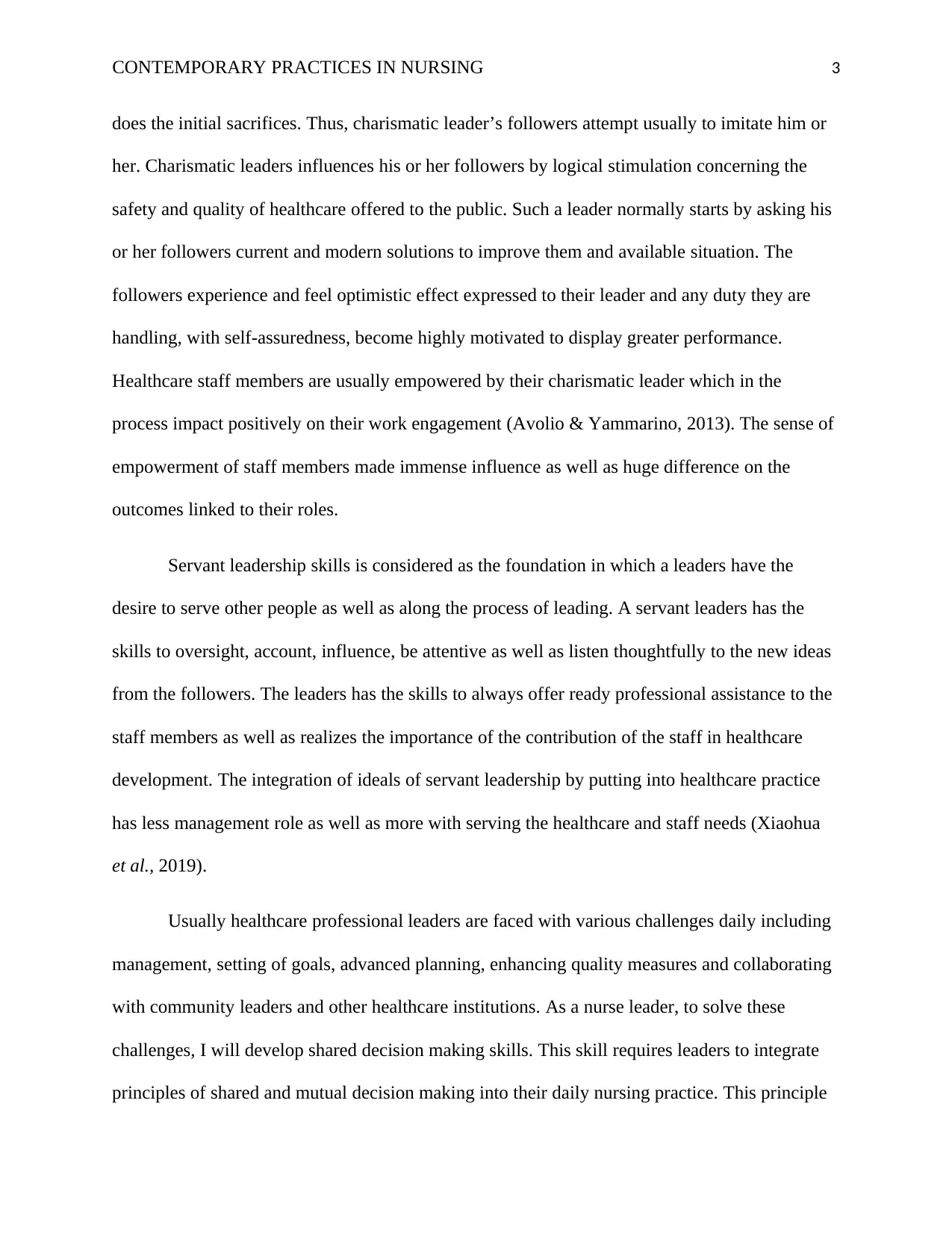
CONTEMPORARY PRACTICES IN NURSING 3
does the initial sacrifices. Thus, charismatic leader’s followers attempt usually to imitate him or
her. Charismatic leaders influences his or her followers by logical stimulation concerning the
safety and quality of healthcare offered to the public. Such a leader normally starts by asking his
or her followers current and modern solutions to improve them and available situation. The
followers experience and feel optimistic effect expressed to their leader and any duty they are
handling, with self-assuredness, become highly motivated to display greater performance.
Healthcare staff members are usually empowered by their charismatic leader which in the
process impact positively on their work engagement (Avolio & Yammarino, 2013). The sense of
empowerment of staff members made immense influence as well as huge difference on the
outcomes linked to their roles.
Servant leadership skills is considered as the foundation in which a leaders have the
desire to serve other people as well as along the process of leading. A servant leaders has the
skills to oversight, account, influence, be attentive as well as listen thoughtfully to the new ideas
from the followers. The leaders has the skills to always offer ready professional assistance to the
staff members as well as realizes the importance of the contribution of the staff in healthcare
development. The integration of ideals of servant leadership by putting into healthcare practice
has less management role as well as more with serving the healthcare and staff needs (Xiaohua
et al., 2019).
Usually healthcare professional leaders are faced with various challenges daily including
management, setting of goals, advanced planning, enhancing quality measures and collaborating
with community leaders and other healthcare institutions. As a nurse leader, to solve these
challenges, I will develop shared decision making skills. This skill requires leaders to integrate
principles of shared and mutual decision making into their daily nursing practice. This principle
does the initial sacrifices. Thus, charismatic leader’s followers attempt usually to imitate him or
her. Charismatic leaders influences his or her followers by logical stimulation concerning the
safety and quality of healthcare offered to the public. Such a leader normally starts by asking his
or her followers current and modern solutions to improve them and available situation. The
followers experience and feel optimistic effect expressed to their leader and any duty they are
handling, with self-assuredness, become highly motivated to display greater performance.
Healthcare staff members are usually empowered by their charismatic leader which in the
process impact positively on their work engagement (Avolio & Yammarino, 2013). The sense of
empowerment of staff members made immense influence as well as huge difference on the
outcomes linked to their roles.
Servant leadership skills is considered as the foundation in which a leaders have the
desire to serve other people as well as along the process of leading. A servant leaders has the
skills to oversight, account, influence, be attentive as well as listen thoughtfully to the new ideas
from the followers. The leaders has the skills to always offer ready professional assistance to the
staff members as well as realizes the importance of the contribution of the staff in healthcare
development. The integration of ideals of servant leadership by putting into healthcare practice
has less management role as well as more with serving the healthcare and staff needs (Xiaohua
et al., 2019).
Usually healthcare professional leaders are faced with various challenges daily including
management, setting of goals, advanced planning, enhancing quality measures and collaborating
with community leaders and other healthcare institutions. As a nurse leader, to solve these
challenges, I will develop shared decision making skills. This skill requires leaders to integrate
principles of shared and mutual decision making into their daily nursing practice. This principle
⊘ This is a preview!⊘
Do you want full access?
Subscribe today to unlock all pages.

Trusted by 1+ million students worldwide
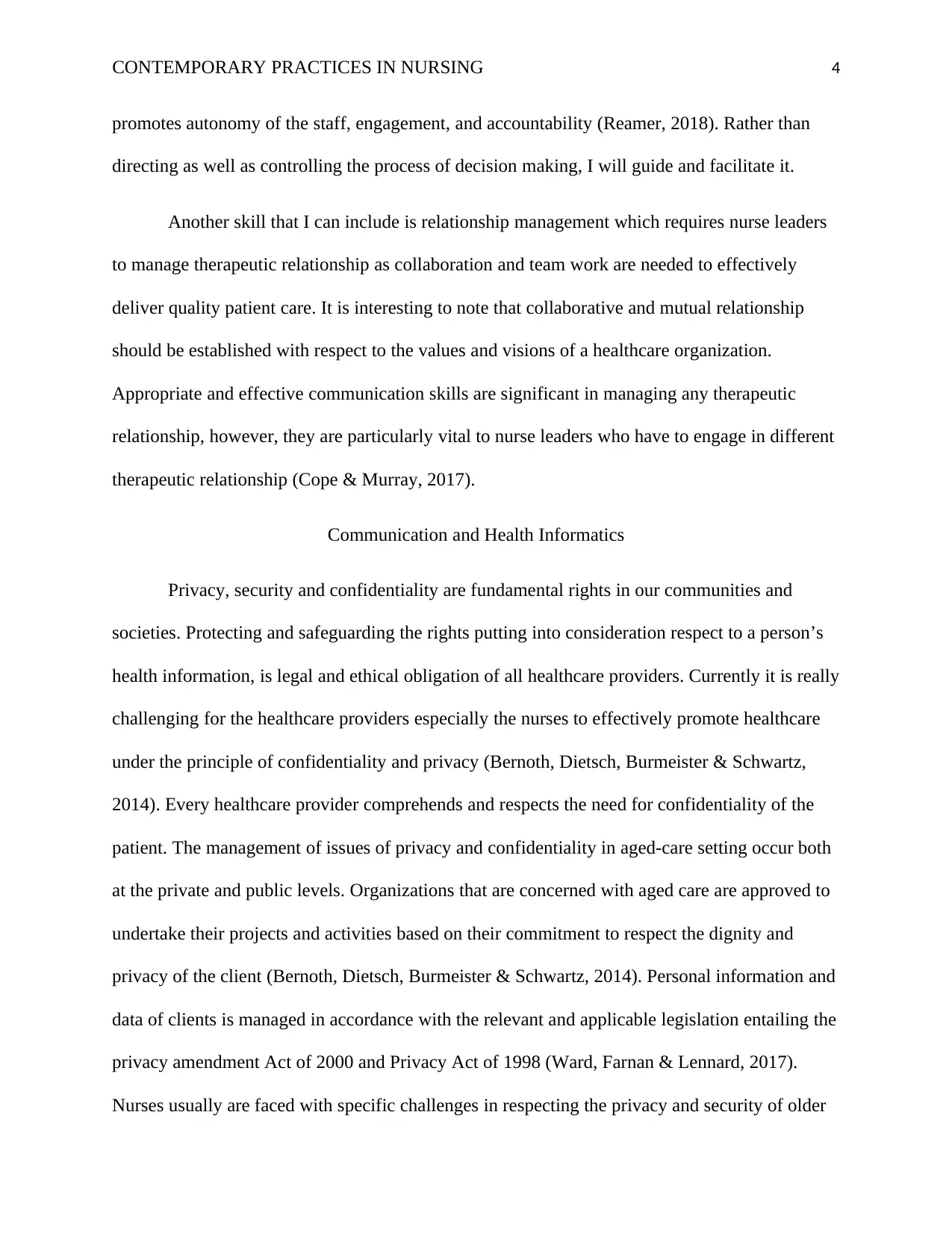
CONTEMPORARY PRACTICES IN NURSING 4
promotes autonomy of the staff, engagement, and accountability (Reamer, 2018). Rather than
directing as well as controlling the process of decision making, I will guide and facilitate it.
Another skill that I can include is relationship management which requires nurse leaders
to manage therapeutic relationship as collaboration and team work are needed to effectively
deliver quality patient care. It is interesting to note that collaborative and mutual relationship
should be established with respect to the values and visions of a healthcare organization.
Appropriate and effective communication skills are significant in managing any therapeutic
relationship, however, they are particularly vital to nurse leaders who have to engage in different
therapeutic relationship (Cope & Murray, 2017).
Communication and Health Informatics
Privacy, security and confidentiality are fundamental rights in our communities and
societies. Protecting and safeguarding the rights putting into consideration respect to a person’s
health information, is legal and ethical obligation of all healthcare providers. Currently it is really
challenging for the healthcare providers especially the nurses to effectively promote healthcare
under the principle of confidentiality and privacy (Bernoth, Dietsch, Burmeister & Schwartz,
2014). Every healthcare provider comprehends and respects the need for confidentiality of the
patient. The management of issues of privacy and confidentiality in aged-care setting occur both
at the private and public levels. Organizations that are concerned with aged care are approved to
undertake their projects and activities based on their commitment to respect the dignity and
privacy of the client (Bernoth, Dietsch, Burmeister & Schwartz, 2014). Personal information and
data of clients is managed in accordance with the relevant and applicable legislation entailing the
privacy amendment Act of 2000 and Privacy Act of 1998 (Ward, Farnan & Lennard, 2017).
Nurses usually are faced with specific challenges in respecting the privacy and security of older
promotes autonomy of the staff, engagement, and accountability (Reamer, 2018). Rather than
directing as well as controlling the process of decision making, I will guide and facilitate it.
Another skill that I can include is relationship management which requires nurse leaders
to manage therapeutic relationship as collaboration and team work are needed to effectively
deliver quality patient care. It is interesting to note that collaborative and mutual relationship
should be established with respect to the values and visions of a healthcare organization.
Appropriate and effective communication skills are significant in managing any therapeutic
relationship, however, they are particularly vital to nurse leaders who have to engage in different
therapeutic relationship (Cope & Murray, 2017).
Communication and Health Informatics
Privacy, security and confidentiality are fundamental rights in our communities and
societies. Protecting and safeguarding the rights putting into consideration respect to a person’s
health information, is legal and ethical obligation of all healthcare providers. Currently it is really
challenging for the healthcare providers especially the nurses to effectively promote healthcare
under the principle of confidentiality and privacy (Bernoth, Dietsch, Burmeister & Schwartz,
2014). Every healthcare provider comprehends and respects the need for confidentiality of the
patient. The management of issues of privacy and confidentiality in aged-care setting occur both
at the private and public levels. Organizations that are concerned with aged care are approved to
undertake their projects and activities based on their commitment to respect the dignity and
privacy of the client (Bernoth, Dietsch, Burmeister & Schwartz, 2014). Personal information and
data of clients is managed in accordance with the relevant and applicable legislation entailing the
privacy amendment Act of 2000 and Privacy Act of 1998 (Ward, Farnan & Lennard, 2017).
Nurses usually are faced with specific challenges in respecting the privacy and security of older
Paraphrase This Document
Need a fresh take? Get an instant paraphrase of this document with our AI Paraphraser
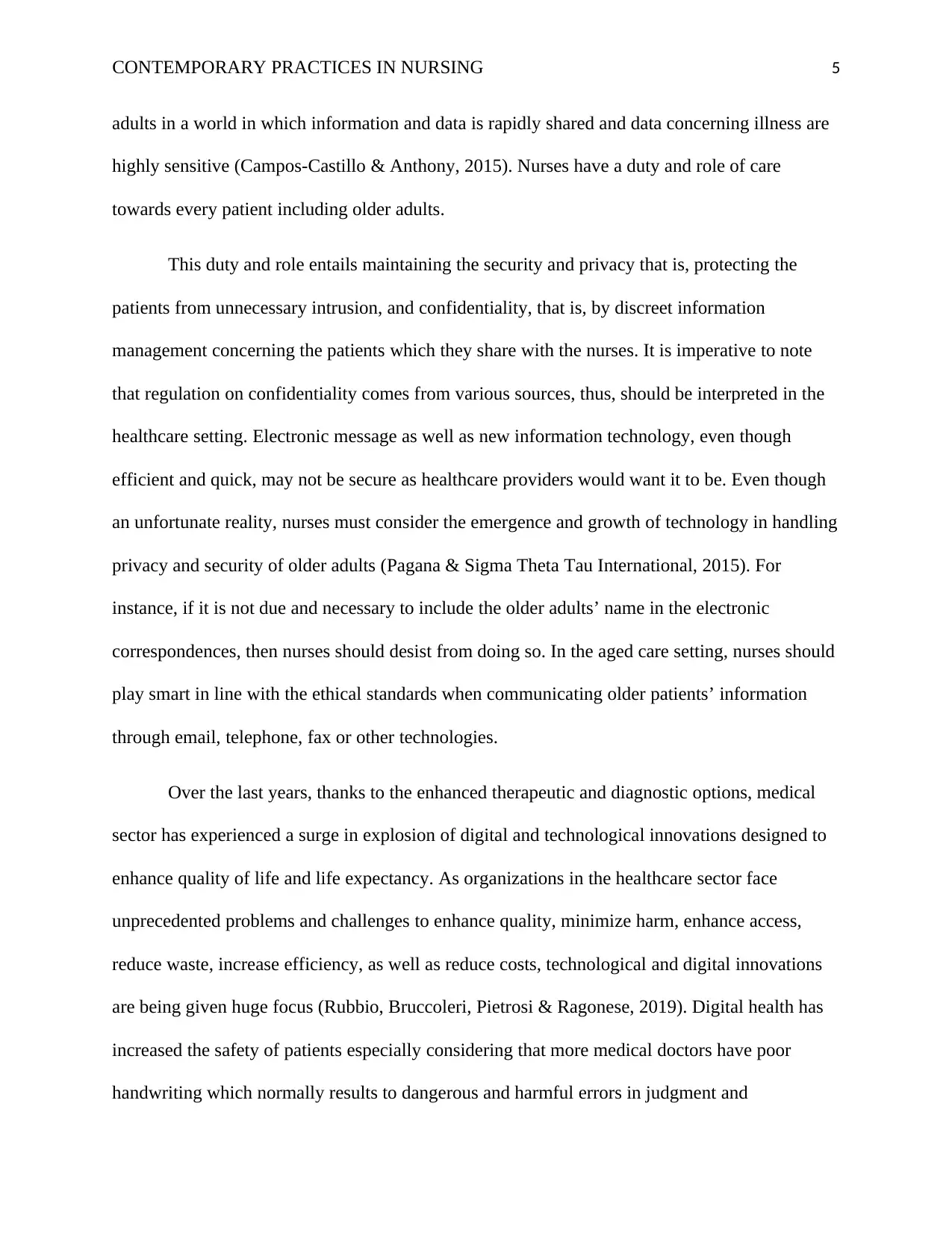
CONTEMPORARY PRACTICES IN NURSING 5
adults in a world in which information and data is rapidly shared and data concerning illness are
highly sensitive (Campos-Castillo & Anthony, 2015). Nurses have a duty and role of care
towards every patient including older adults.
This duty and role entails maintaining the security and privacy that is, protecting the
patients from unnecessary intrusion, and confidentiality, that is, by discreet information
management concerning the patients which they share with the nurses. It is imperative to note
that regulation on confidentiality comes from various sources, thus, should be interpreted in the
healthcare setting. Electronic message as well as new information technology, even though
efficient and quick, may not be secure as healthcare providers would want it to be. Even though
an unfortunate reality, nurses must consider the emergence and growth of technology in handling
privacy and security of older adults (Pagana & Sigma Theta Tau International, 2015). For
instance, if it is not due and necessary to include the older adults’ name in the electronic
correspondences, then nurses should desist from doing so. In the aged care setting, nurses should
play smart in line with the ethical standards when communicating older patients’ information
through email, telephone, fax or other technologies.
Over the last years, thanks to the enhanced therapeutic and diagnostic options, medical
sector has experienced a surge in explosion of digital and technological innovations designed to
enhance quality of life and life expectancy. As organizations in the healthcare sector face
unprecedented problems and challenges to enhance quality, minimize harm, enhance access,
reduce waste, increase efficiency, as well as reduce costs, technological and digital innovations
are being given huge focus (Rubbio, Bruccoleri, Pietrosi & Ragonese, 2019). Digital health has
increased the safety of patients especially considering that more medical doctors have poor
handwriting which normally results to dangerous and harmful errors in judgment and
adults in a world in which information and data is rapidly shared and data concerning illness are
highly sensitive (Campos-Castillo & Anthony, 2015). Nurses have a duty and role of care
towards every patient including older adults.
This duty and role entails maintaining the security and privacy that is, protecting the
patients from unnecessary intrusion, and confidentiality, that is, by discreet information
management concerning the patients which they share with the nurses. It is imperative to note
that regulation on confidentiality comes from various sources, thus, should be interpreted in the
healthcare setting. Electronic message as well as new information technology, even though
efficient and quick, may not be secure as healthcare providers would want it to be. Even though
an unfortunate reality, nurses must consider the emergence and growth of technology in handling
privacy and security of older adults (Pagana & Sigma Theta Tau International, 2015). For
instance, if it is not due and necessary to include the older adults’ name in the electronic
correspondences, then nurses should desist from doing so. In the aged care setting, nurses should
play smart in line with the ethical standards when communicating older patients’ information
through email, telephone, fax or other technologies.
Over the last years, thanks to the enhanced therapeutic and diagnostic options, medical
sector has experienced a surge in explosion of digital and technological innovations designed to
enhance quality of life and life expectancy. As organizations in the healthcare sector face
unprecedented problems and challenges to enhance quality, minimize harm, enhance access,
reduce waste, increase efficiency, as well as reduce costs, technological and digital innovations
are being given huge focus (Rubbio, Bruccoleri, Pietrosi & Ragonese, 2019). Digital health has
increased the safety of patients especially considering that more medical doctors have poor
handwriting which normally results to dangerous and harmful errors in judgment and
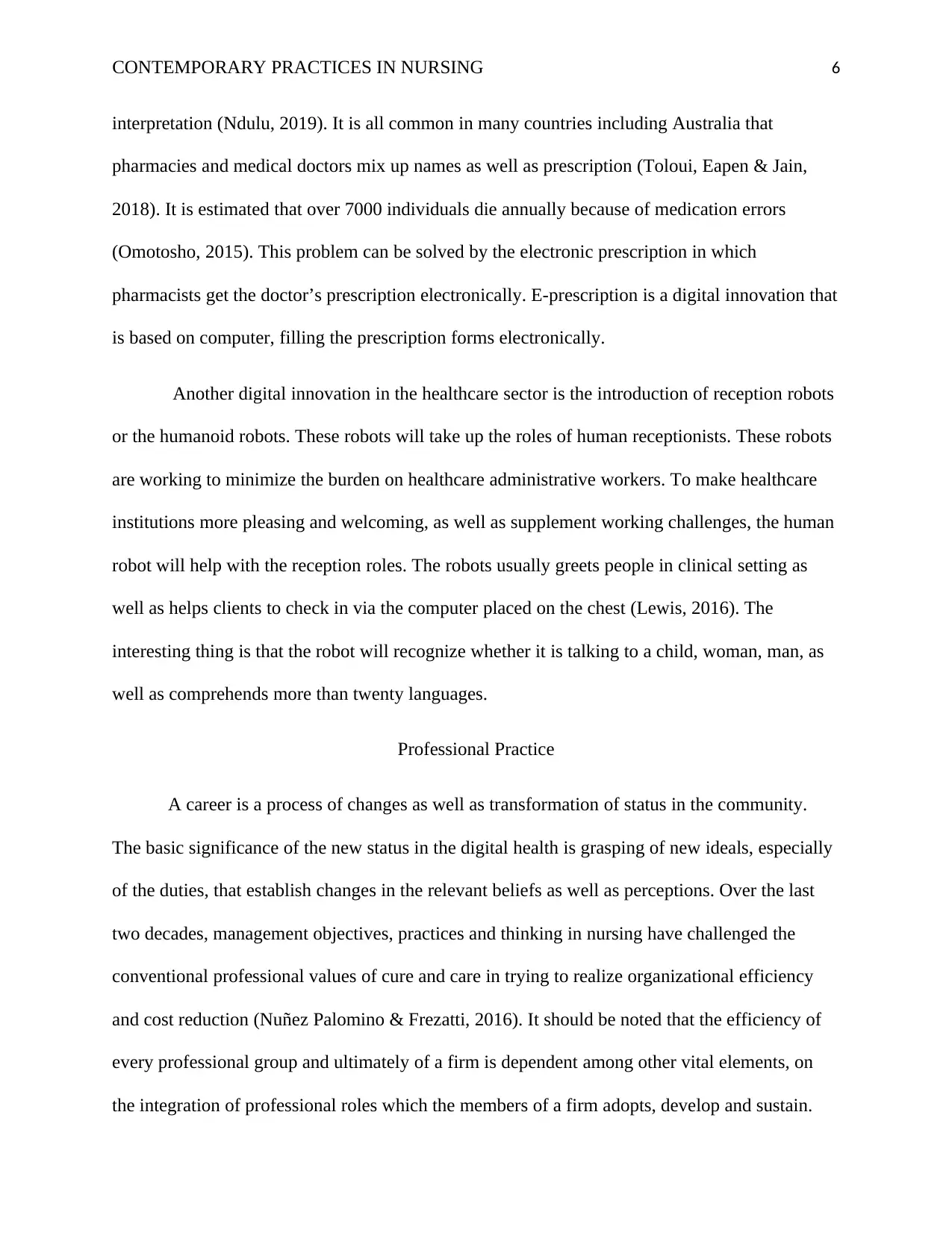
CONTEMPORARY PRACTICES IN NURSING 6
interpretation (Ndulu, 2019). It is all common in many countries including Australia that
pharmacies and medical doctors mix up names as well as prescription (Toloui, Eapen & Jain,
2018). It is estimated that over 7000 individuals die annually because of medication errors
(Omotosho, 2015). This problem can be solved by the electronic prescription in which
pharmacists get the doctor’s prescription electronically. E-prescription is a digital innovation that
is based on computer, filling the prescription forms electronically.
Another digital innovation in the healthcare sector is the introduction of reception robots
or the humanoid robots. These robots will take up the roles of human receptionists. These robots
are working to minimize the burden on healthcare administrative workers. To make healthcare
institutions more pleasing and welcoming, as well as supplement working challenges, the human
robot will help with the reception roles. The robots usually greets people in clinical setting as
well as helps clients to check in via the computer placed on the chest (Lewis, 2016). The
interesting thing is that the robot will recognize whether it is talking to a child, woman, man, as
well as comprehends more than twenty languages.
Professional Practice
A career is a process of changes as well as transformation of status in the community.
The basic significance of the new status in the digital health is grasping of new ideals, especially
of the duties, that establish changes in the relevant beliefs as well as perceptions. Over the last
two decades, management objectives, practices and thinking in nursing have challenged the
conventional professional values of cure and care in trying to realize organizational efficiency
and cost reduction (Nuñez Palomino & Frezatti, 2016). It should be noted that the efficiency of
every professional group and ultimately of a firm is dependent among other vital elements, on
the integration of professional roles which the members of a firm adopts, develop and sustain.
interpretation (Ndulu, 2019). It is all common in many countries including Australia that
pharmacies and medical doctors mix up names as well as prescription (Toloui, Eapen & Jain,
2018). It is estimated that over 7000 individuals die annually because of medication errors
(Omotosho, 2015). This problem can be solved by the electronic prescription in which
pharmacists get the doctor’s prescription electronically. E-prescription is a digital innovation that
is based on computer, filling the prescription forms electronically.
Another digital innovation in the healthcare sector is the introduction of reception robots
or the humanoid robots. These robots will take up the roles of human receptionists. These robots
are working to minimize the burden on healthcare administrative workers. To make healthcare
institutions more pleasing and welcoming, as well as supplement working challenges, the human
robot will help with the reception roles. The robots usually greets people in clinical setting as
well as helps clients to check in via the computer placed on the chest (Lewis, 2016). The
interesting thing is that the robot will recognize whether it is talking to a child, woman, man, as
well as comprehends more than twenty languages.
Professional Practice
A career is a process of changes as well as transformation of status in the community.
The basic significance of the new status in the digital health is grasping of new ideals, especially
of the duties, that establish changes in the relevant beliefs as well as perceptions. Over the last
two decades, management objectives, practices and thinking in nursing have challenged the
conventional professional values of cure and care in trying to realize organizational efficiency
and cost reduction (Nuñez Palomino & Frezatti, 2016). It should be noted that the efficiency of
every professional group and ultimately of a firm is dependent among other vital elements, on
the integration of professional roles which the members of a firm adopts, develop and sustain.
⊘ This is a preview!⊘
Do you want full access?
Subscribe today to unlock all pages.

Trusted by 1+ million students worldwide
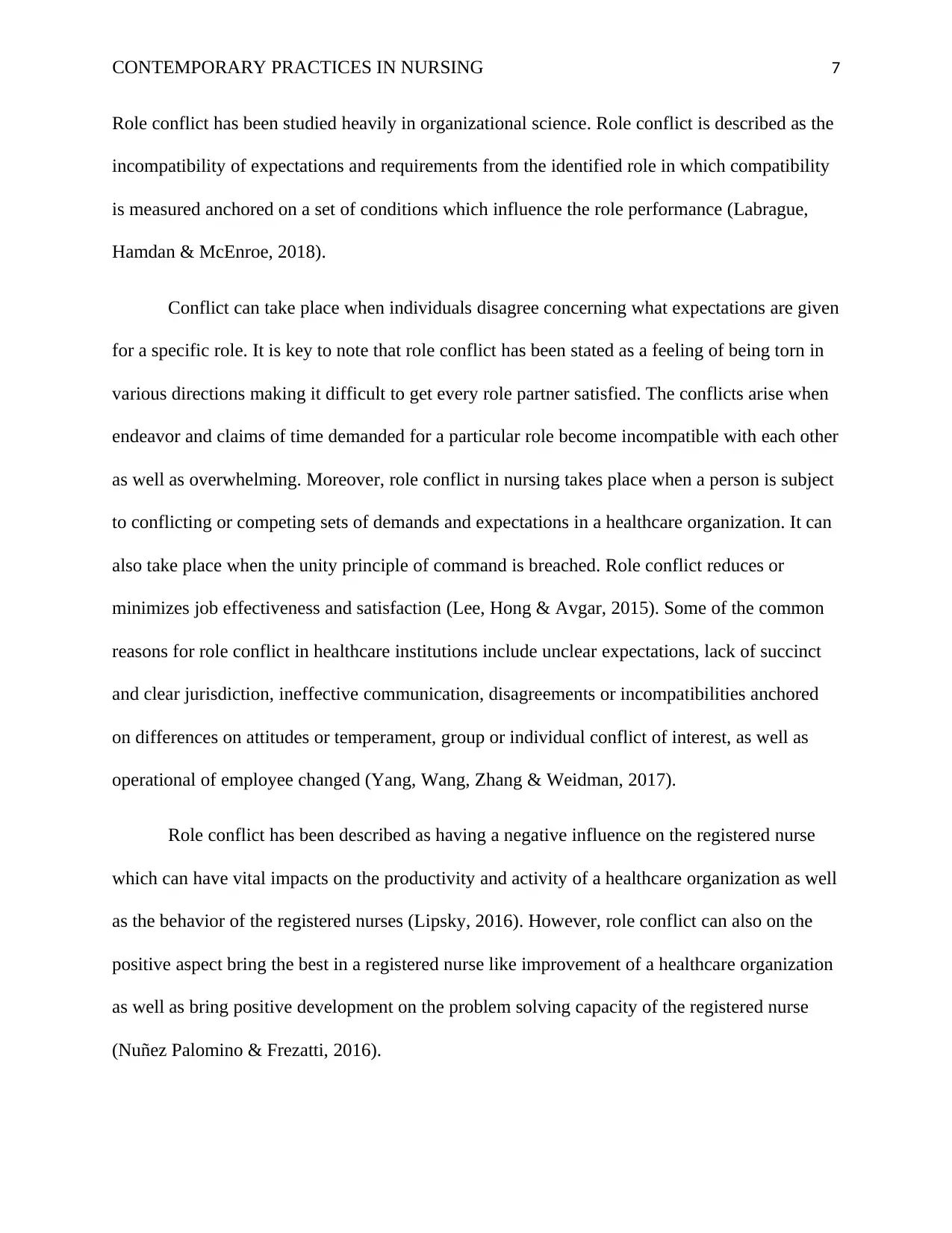
CONTEMPORARY PRACTICES IN NURSING 7
Role conflict has been studied heavily in organizational science. Role conflict is described as the
incompatibility of expectations and requirements from the identified role in which compatibility
is measured anchored on a set of conditions which influence the role performance (Labrague,
Hamdan & McEnroe, 2018).
Conflict can take place when individuals disagree concerning what expectations are given
for a specific role. It is key to note that role conflict has been stated as a feeling of being torn in
various directions making it difficult to get every role partner satisfied. The conflicts arise when
endeavor and claims of time demanded for a particular role become incompatible with each other
as well as overwhelming. Moreover, role conflict in nursing takes place when a person is subject
to conflicting or competing sets of demands and expectations in a healthcare organization. It can
also take place when the unity principle of command is breached. Role conflict reduces or
minimizes job effectiveness and satisfaction (Lee, Hong & Avgar, 2015). Some of the common
reasons for role conflict in healthcare institutions include unclear expectations, lack of succinct
and clear jurisdiction, ineffective communication, disagreements or incompatibilities anchored
on differences on attitudes or temperament, group or individual conflict of interest, as well as
operational of employee changed (Yang, Wang, Zhang & Weidman, 2017).
Role conflict has been described as having a negative influence on the registered nurse
which can have vital impacts on the productivity and activity of a healthcare organization as well
as the behavior of the registered nurses (Lipsky, 2016). However, role conflict can also on the
positive aspect bring the best in a registered nurse like improvement of a healthcare organization
as well as bring positive development on the problem solving capacity of the registered nurse
(Nuñez Palomino & Frezatti, 2016).
Role conflict has been studied heavily in organizational science. Role conflict is described as the
incompatibility of expectations and requirements from the identified role in which compatibility
is measured anchored on a set of conditions which influence the role performance (Labrague,
Hamdan & McEnroe, 2018).
Conflict can take place when individuals disagree concerning what expectations are given
for a specific role. It is key to note that role conflict has been stated as a feeling of being torn in
various directions making it difficult to get every role partner satisfied. The conflicts arise when
endeavor and claims of time demanded for a particular role become incompatible with each other
as well as overwhelming. Moreover, role conflict in nursing takes place when a person is subject
to conflicting or competing sets of demands and expectations in a healthcare organization. It can
also take place when the unity principle of command is breached. Role conflict reduces or
minimizes job effectiveness and satisfaction (Lee, Hong & Avgar, 2015). Some of the common
reasons for role conflict in healthcare institutions include unclear expectations, lack of succinct
and clear jurisdiction, ineffective communication, disagreements or incompatibilities anchored
on differences on attitudes or temperament, group or individual conflict of interest, as well as
operational of employee changed (Yang, Wang, Zhang & Weidman, 2017).
Role conflict has been described as having a negative influence on the registered nurse
which can have vital impacts on the productivity and activity of a healthcare organization as well
as the behavior of the registered nurses (Lipsky, 2016). However, role conflict can also on the
positive aspect bring the best in a registered nurse like improvement of a healthcare organization
as well as bring positive development on the problem solving capacity of the registered nurse
(Nuñez Palomino & Frezatti, 2016).
Paraphrase This Document
Need a fresh take? Get an instant paraphrase of this document with our AI Paraphraser
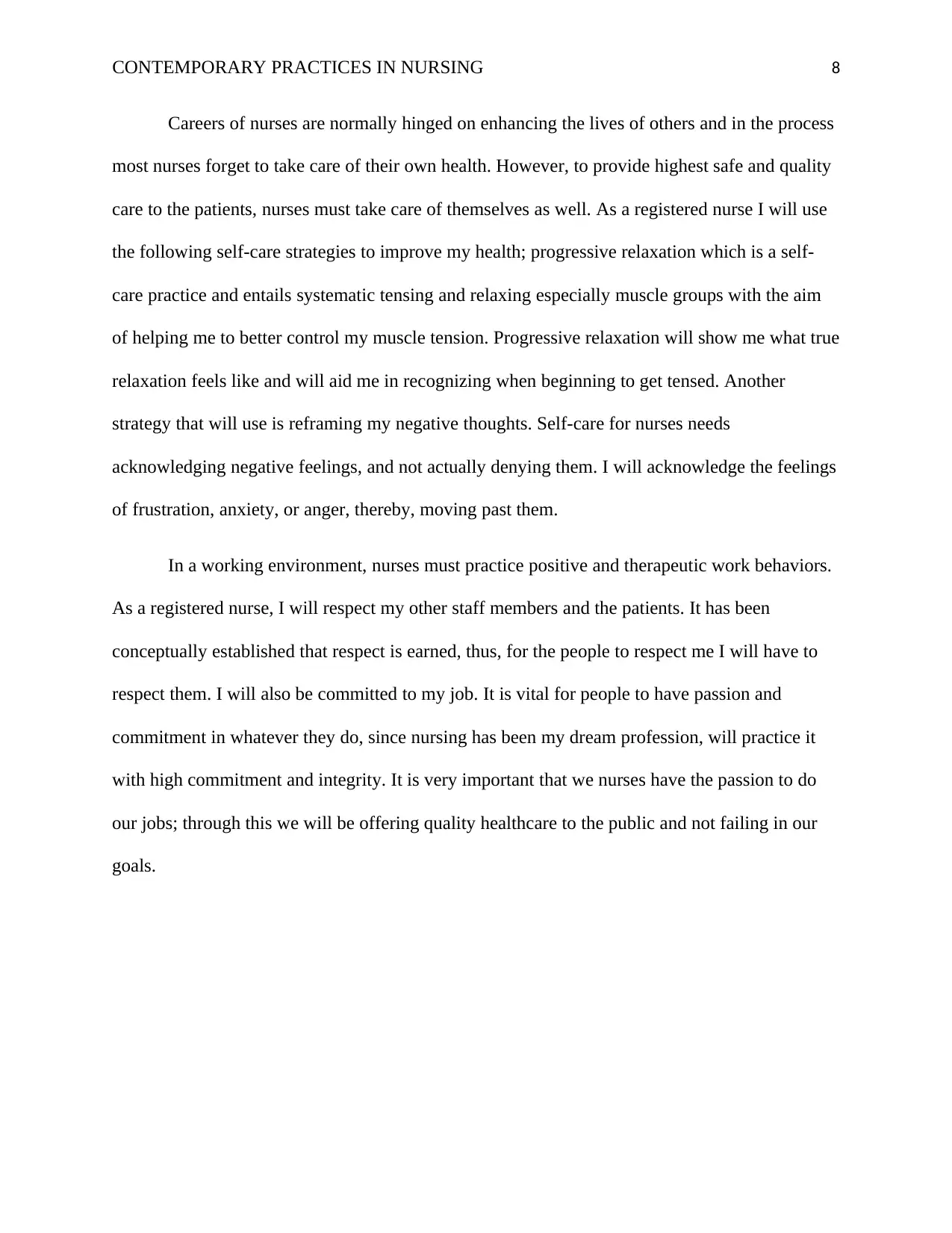
CONTEMPORARY PRACTICES IN NURSING 8
Careers of nurses are normally hinged on enhancing the lives of others and in the process
most nurses forget to take care of their own health. However, to provide highest safe and quality
care to the patients, nurses must take care of themselves as well. As a registered nurse I will use
the following self-care strategies to improve my health; progressive relaxation which is a self-
care practice and entails systematic tensing and relaxing especially muscle groups with the aim
of helping me to better control my muscle tension. Progressive relaxation will show me what true
relaxation feels like and will aid me in recognizing when beginning to get tensed. Another
strategy that will use is reframing my negative thoughts. Self-care for nurses needs
acknowledging negative feelings, and not actually denying them. I will acknowledge the feelings
of frustration, anxiety, or anger, thereby, moving past them.
In a working environment, nurses must practice positive and therapeutic work behaviors.
As a registered nurse, I will respect my other staff members and the patients. It has been
conceptually established that respect is earned, thus, for the people to respect me I will have to
respect them. I will also be committed to my job. It is vital for people to have passion and
commitment in whatever they do, since nursing has been my dream profession, will practice it
with high commitment and integrity. It is very important that we nurses have the passion to do
our jobs; through this we will be offering quality healthcare to the public and not failing in our
goals.
Careers of nurses are normally hinged on enhancing the lives of others and in the process
most nurses forget to take care of their own health. However, to provide highest safe and quality
care to the patients, nurses must take care of themselves as well. As a registered nurse I will use
the following self-care strategies to improve my health; progressive relaxation which is a self-
care practice and entails systematic tensing and relaxing especially muscle groups with the aim
of helping me to better control my muscle tension. Progressive relaxation will show me what true
relaxation feels like and will aid me in recognizing when beginning to get tensed. Another
strategy that will use is reframing my negative thoughts. Self-care for nurses needs
acknowledging negative feelings, and not actually denying them. I will acknowledge the feelings
of frustration, anxiety, or anger, thereby, moving past them.
In a working environment, nurses must practice positive and therapeutic work behaviors.
As a registered nurse, I will respect my other staff members and the patients. It has been
conceptually established that respect is earned, thus, for the people to respect me I will have to
respect them. I will also be committed to my job. It is vital for people to have passion and
commitment in whatever they do, since nursing has been my dream profession, will practice it
with high commitment and integrity. It is very important that we nurses have the passion to do
our jobs; through this we will be offering quality healthcare to the public and not failing in our
goals.
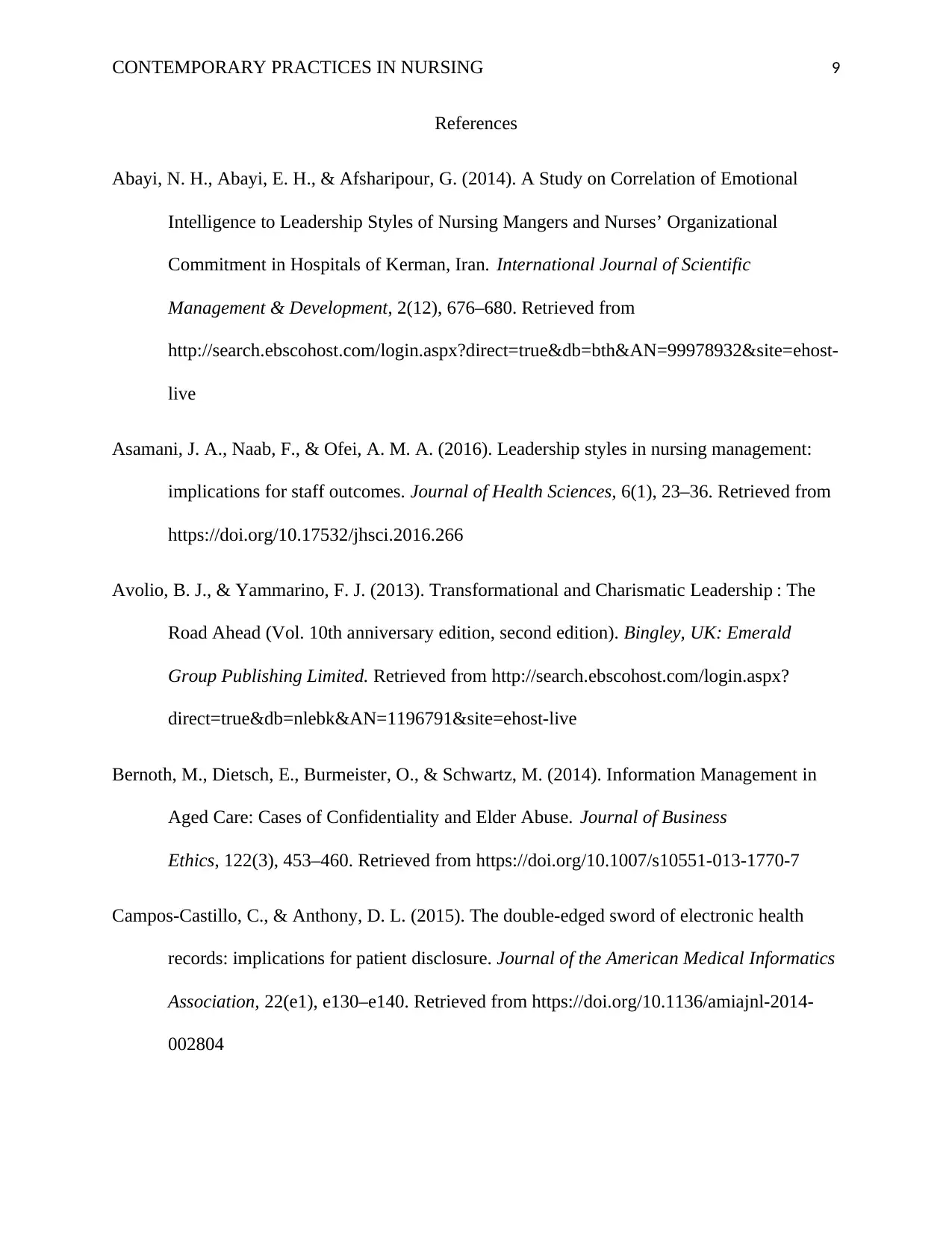
CONTEMPORARY PRACTICES IN NURSING 9
References
Abayi, N. H., Abayi, E. H., & Afsharipour, G. (2014). A Study on Correlation of Emotional
Intelligence to Leadership Styles of Nursing Mangers and Nurses’ Organizational
Commitment in Hospitals of Kerman, Iran. International Journal of Scientific
Management & Development, 2(12), 676–680. Retrieved from
http://search.ebscohost.com/login.aspx?direct=true&db=bth&AN=99978932&site=ehost-
live
Asamani, J. A., Naab, F., & Ofei, A. M. A. (2016). Leadership styles in nursing management:
implications for staff outcomes. Journal of Health Sciences, 6(1), 23–36. Retrieved from
https://doi.org/10.17532/jhsci.2016.266
Avolio, B. J., & Yammarino, F. J. (2013). Transformational and Charismatic Leadership : The
Road Ahead (Vol. 10th anniversary edition, second edition). Bingley, UK: Emerald
Group Publishing Limited. Retrieved from http://search.ebscohost.com/login.aspx?
direct=true&db=nlebk&AN=1196791&site=ehost-live
Bernoth, M., Dietsch, E., Burmeister, O., & Schwartz, M. (2014). Information Management in
Aged Care: Cases of Confidentiality and Elder Abuse. Journal of Business
Ethics, 122(3), 453–460. Retrieved from https://doi.org/10.1007/s10551-013-1770-7
Campos-Castillo, C., & Anthony, D. L. (2015). The double-edged sword of electronic health
records: implications for patient disclosure. Journal of the American Medical Informatics
Association, 22(e1), e130–e140. Retrieved from https://doi.org/10.1136/amiajnl-2014-
002804
References
Abayi, N. H., Abayi, E. H., & Afsharipour, G. (2014). A Study on Correlation of Emotional
Intelligence to Leadership Styles of Nursing Mangers and Nurses’ Organizational
Commitment in Hospitals of Kerman, Iran. International Journal of Scientific
Management & Development, 2(12), 676–680. Retrieved from
http://search.ebscohost.com/login.aspx?direct=true&db=bth&AN=99978932&site=ehost-
live
Asamani, J. A., Naab, F., & Ofei, A. M. A. (2016). Leadership styles in nursing management:
implications for staff outcomes. Journal of Health Sciences, 6(1), 23–36. Retrieved from
https://doi.org/10.17532/jhsci.2016.266
Avolio, B. J., & Yammarino, F. J. (2013). Transformational and Charismatic Leadership : The
Road Ahead (Vol. 10th anniversary edition, second edition). Bingley, UK: Emerald
Group Publishing Limited. Retrieved from http://search.ebscohost.com/login.aspx?
direct=true&db=nlebk&AN=1196791&site=ehost-live
Bernoth, M., Dietsch, E., Burmeister, O., & Schwartz, M. (2014). Information Management in
Aged Care: Cases of Confidentiality and Elder Abuse. Journal of Business
Ethics, 122(3), 453–460. Retrieved from https://doi.org/10.1007/s10551-013-1770-7
Campos-Castillo, C., & Anthony, D. L. (2015). The double-edged sword of electronic health
records: implications for patient disclosure. Journal of the American Medical Informatics
Association, 22(e1), e130–e140. Retrieved from https://doi.org/10.1136/amiajnl-2014-
002804
⊘ This is a preview!⊘
Do you want full access?
Subscribe today to unlock all pages.

Trusted by 1+ million students worldwide
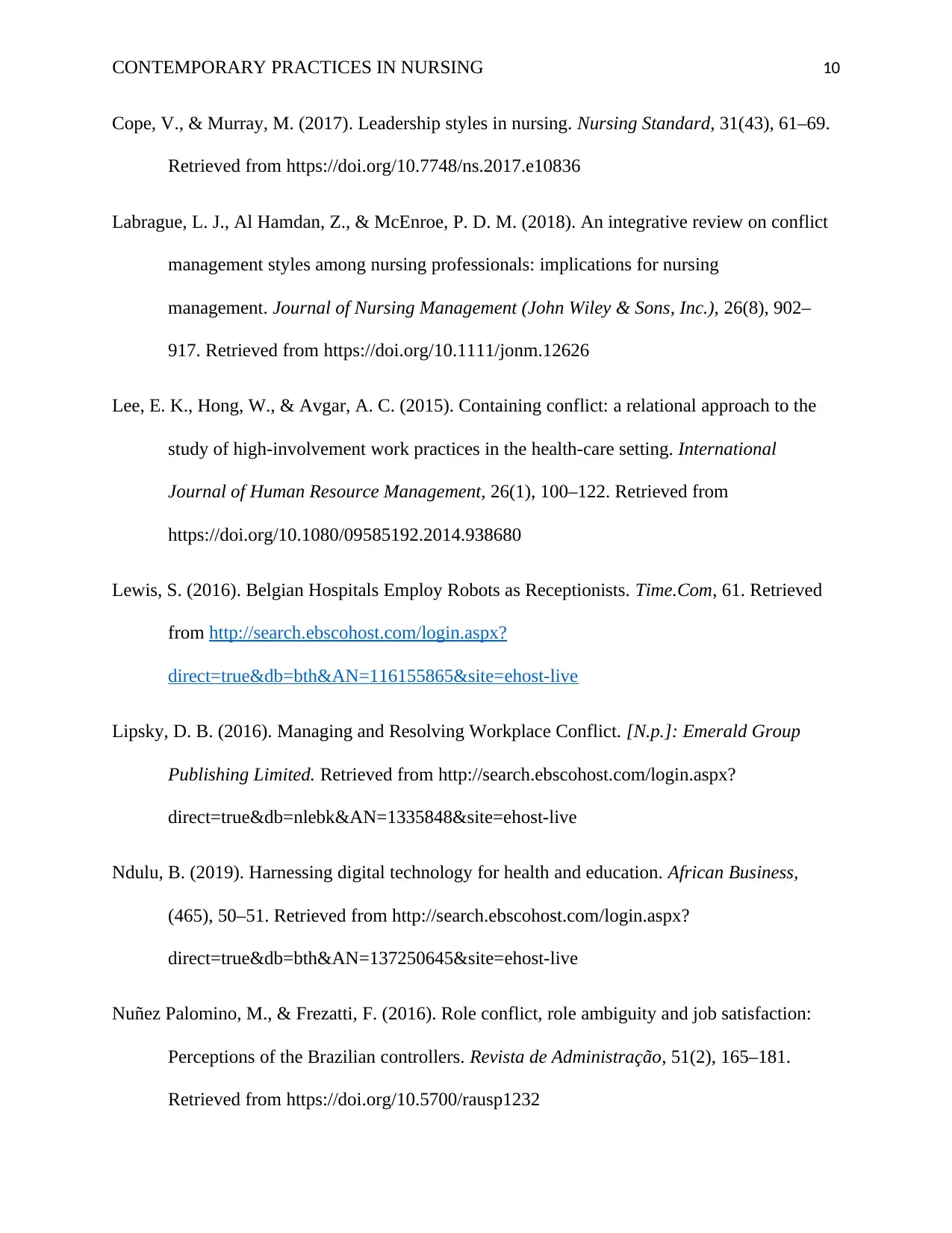
CONTEMPORARY PRACTICES IN NURSING 10
Cope, V., & Murray, M. (2017). Leadership styles in nursing. Nursing Standard, 31(43), 61–69.
Retrieved from https://doi.org/10.7748/ns.2017.e10836
Labrague, L. J., Al Hamdan, Z., & McEnroe, P. D. M. (2018). An integrative review on conflict
management styles among nursing professionals: implications for nursing
management. Journal of Nursing Management (John Wiley & Sons, Inc.), 26(8), 902–
917. Retrieved from https://doi.org/10.1111/jonm.12626
Lee, E. K., Hong, W., & Avgar, A. C. (2015). Containing conflict: a relational approach to the
study of high-involvement work practices in the health-care setting. International
Journal of Human Resource Management, 26(1), 100–122. Retrieved from
https://doi.org/10.1080/09585192.2014.938680
Lewis, S. (2016). Belgian Hospitals Employ Robots as Receptionists. Time.Com, 61. Retrieved
from http://search.ebscohost.com/login.aspx?
direct=true&db=bth&AN=116155865&site=ehost-live
Lipsky, D. B. (2016). Managing and Resolving Workplace Conflict. [N.p.]: Emerald Group
Publishing Limited. Retrieved from http://search.ebscohost.com/login.aspx?
direct=true&db=nlebk&AN=1335848&site=ehost-live
Ndulu, B. (2019). Harnessing digital technology for health and education. African Business,
(465), 50–51. Retrieved from http://search.ebscohost.com/login.aspx?
direct=true&db=bth&AN=137250645&site=ehost-live
Nuñez Palomino, M., & Frezatti, F. (2016). Role conflict, role ambiguity and job satisfaction:
Perceptions of the Brazilian controllers. Revista de Administração, 51(2), 165–181.
Retrieved from https://doi.org/10.5700/rausp1232
Cope, V., & Murray, M. (2017). Leadership styles in nursing. Nursing Standard, 31(43), 61–69.
Retrieved from https://doi.org/10.7748/ns.2017.e10836
Labrague, L. J., Al Hamdan, Z., & McEnroe, P. D. M. (2018). An integrative review on conflict
management styles among nursing professionals: implications for nursing
management. Journal of Nursing Management (John Wiley & Sons, Inc.), 26(8), 902–
917. Retrieved from https://doi.org/10.1111/jonm.12626
Lee, E. K., Hong, W., & Avgar, A. C. (2015). Containing conflict: a relational approach to the
study of high-involvement work practices in the health-care setting. International
Journal of Human Resource Management, 26(1), 100–122. Retrieved from
https://doi.org/10.1080/09585192.2014.938680
Lewis, S. (2016). Belgian Hospitals Employ Robots as Receptionists. Time.Com, 61. Retrieved
from http://search.ebscohost.com/login.aspx?
direct=true&db=bth&AN=116155865&site=ehost-live
Lipsky, D. B. (2016). Managing and Resolving Workplace Conflict. [N.p.]: Emerald Group
Publishing Limited. Retrieved from http://search.ebscohost.com/login.aspx?
direct=true&db=nlebk&AN=1335848&site=ehost-live
Ndulu, B. (2019). Harnessing digital technology for health and education. African Business,
(465), 50–51. Retrieved from http://search.ebscohost.com/login.aspx?
direct=true&db=bth&AN=137250645&site=ehost-live
Nuñez Palomino, M., & Frezatti, F. (2016). Role conflict, role ambiguity and job satisfaction:
Perceptions of the Brazilian controllers. Revista de Administração, 51(2), 165–181.
Retrieved from https://doi.org/10.5700/rausp1232
Paraphrase This Document
Need a fresh take? Get an instant paraphrase of this document with our AI Paraphraser
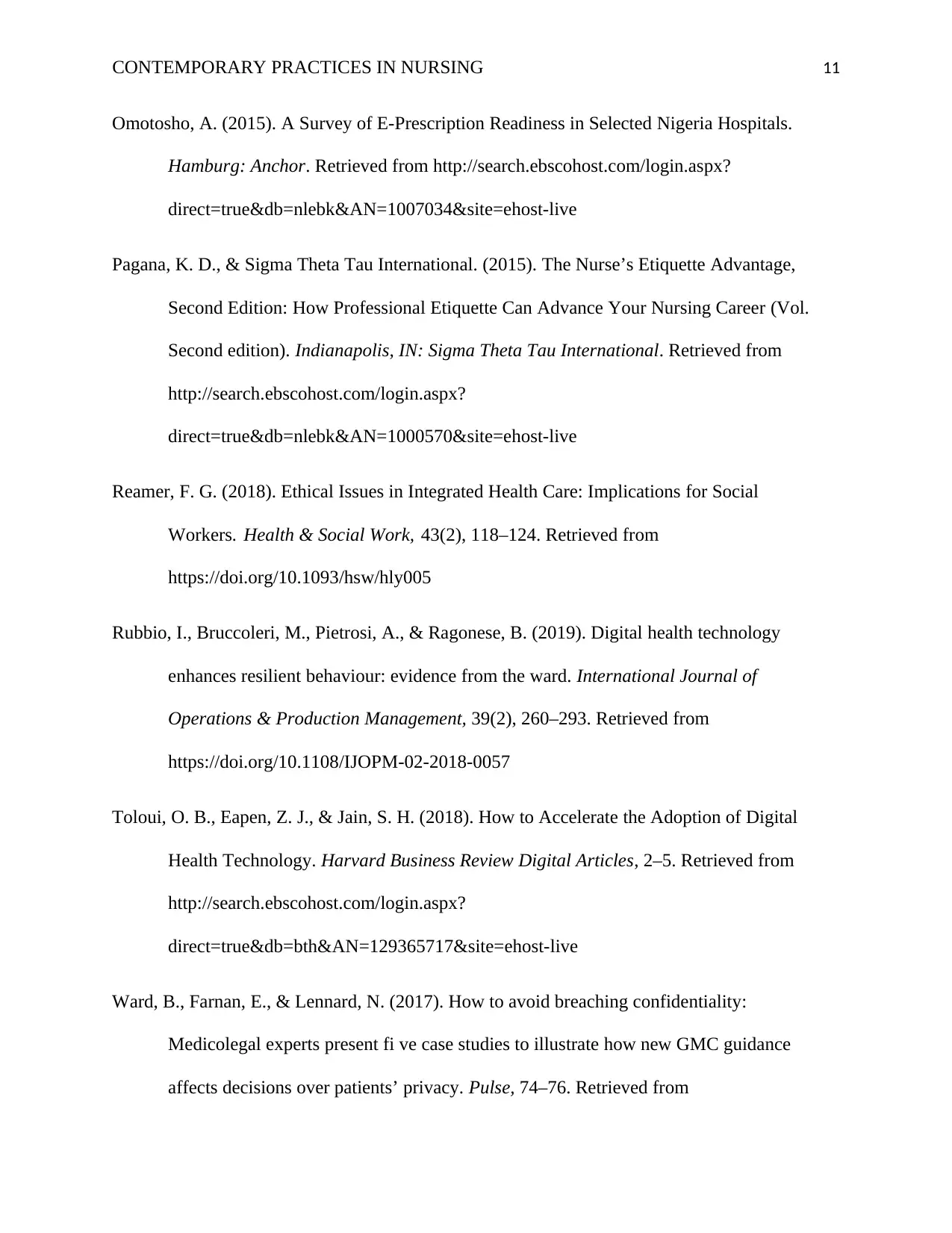
CONTEMPORARY PRACTICES IN NURSING 11
Omotosho, A. (2015). A Survey of E-Prescription Readiness in Selected Nigeria Hospitals.
Hamburg: Anchor. Retrieved from http://search.ebscohost.com/login.aspx?
direct=true&db=nlebk&AN=1007034&site=ehost-live
Pagana, K. D., & Sigma Theta Tau International. (2015). The Nurse’s Etiquette Advantage,
Second Edition: How Professional Etiquette Can Advance Your Nursing Career (Vol.
Second edition). Indianapolis, IN: Sigma Theta Tau International. Retrieved from
http://search.ebscohost.com/login.aspx?
direct=true&db=nlebk&AN=1000570&site=ehost-live
Reamer, F. G. (2018). Ethical Issues in Integrated Health Care: Implications for Social
Workers. Health & Social Work, 43(2), 118–124. Retrieved from
https://doi.org/10.1093/hsw/hly005
Rubbio, I., Bruccoleri, M., Pietrosi, A., & Ragonese, B. (2019). Digital health technology
enhances resilient behaviour: evidence from the ward. International Journal of
Operations & Production Management, 39(2), 260–293. Retrieved from
https://doi.org/10.1108/IJOPM-02-2018-0057
Toloui, O. B., Eapen, Z. J., & Jain, S. H. (2018). How to Accelerate the Adoption of Digital
Health Technology. Harvard Business Review Digital Articles, 2–5. Retrieved from
http://search.ebscohost.com/login.aspx?
direct=true&db=bth&AN=129365717&site=ehost-live
Ward, B., Farnan, E., & Lennard, N. (2017). How to avoid breaching confidentiality:
Medicolegal experts present fi ve case studies to illustrate how new GMC guidance
affects decisions over patients’ privacy. Pulse, 74–76. Retrieved from
Omotosho, A. (2015). A Survey of E-Prescription Readiness in Selected Nigeria Hospitals.
Hamburg: Anchor. Retrieved from http://search.ebscohost.com/login.aspx?
direct=true&db=nlebk&AN=1007034&site=ehost-live
Pagana, K. D., & Sigma Theta Tau International. (2015). The Nurse’s Etiquette Advantage,
Second Edition: How Professional Etiquette Can Advance Your Nursing Career (Vol.
Second edition). Indianapolis, IN: Sigma Theta Tau International. Retrieved from
http://search.ebscohost.com/login.aspx?
direct=true&db=nlebk&AN=1000570&site=ehost-live
Reamer, F. G. (2018). Ethical Issues in Integrated Health Care: Implications for Social
Workers. Health & Social Work, 43(2), 118–124. Retrieved from
https://doi.org/10.1093/hsw/hly005
Rubbio, I., Bruccoleri, M., Pietrosi, A., & Ragonese, B. (2019). Digital health technology
enhances resilient behaviour: evidence from the ward. International Journal of
Operations & Production Management, 39(2), 260–293. Retrieved from
https://doi.org/10.1108/IJOPM-02-2018-0057
Toloui, O. B., Eapen, Z. J., & Jain, S. H. (2018). How to Accelerate the Adoption of Digital
Health Technology. Harvard Business Review Digital Articles, 2–5. Retrieved from
http://search.ebscohost.com/login.aspx?
direct=true&db=bth&AN=129365717&site=ehost-live
Ward, B., Farnan, E., & Lennard, N. (2017). How to avoid breaching confidentiality:
Medicolegal experts present fi ve case studies to illustrate how new GMC guidance
affects decisions over patients’ privacy. Pulse, 74–76. Retrieved from
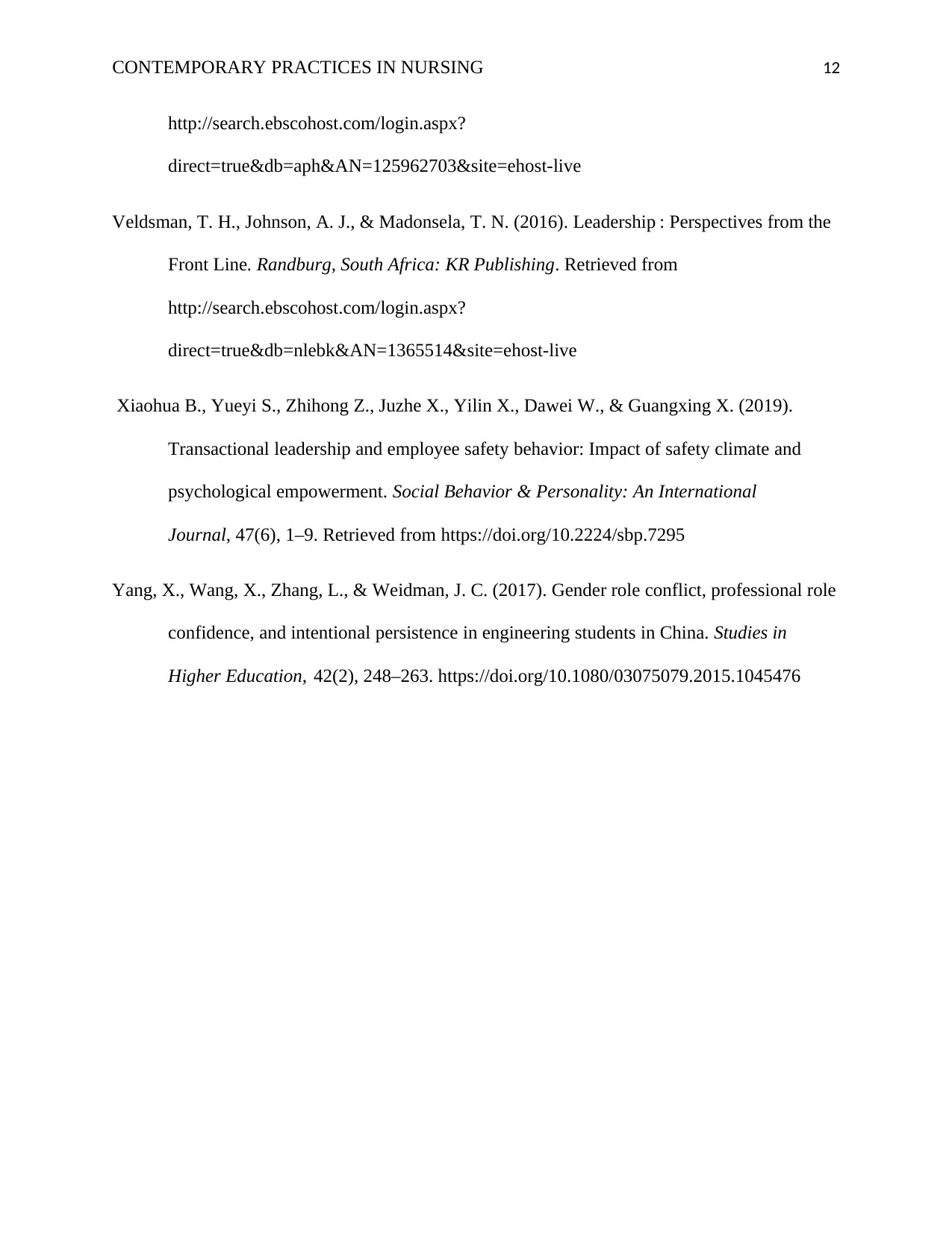
CONTEMPORARY PRACTICES IN NURSING 12
http://search.ebscohost.com/login.aspx?
direct=true&db=aph&AN=125962703&site=ehost-live
Veldsman, T. H., Johnson, A. J., & Madonsela, T. N. (2016). Leadership : Perspectives from the
Front Line. Randburg, South Africa: KR Publishing. Retrieved from
http://search.ebscohost.com/login.aspx?
direct=true&db=nlebk&AN=1365514&site=ehost-live
Xiaohua B., Yueyi S., Zhihong Z., Juzhe X., Yilin X., Dawei W., & Guangxing X. (2019).
Transactional leadership and employee safety behavior: Impact of safety climate and
psychological empowerment. Social Behavior & Personality: An International
Journal, 47(6), 1–9. Retrieved from https://doi.org/10.2224/sbp.7295
Yang, X., Wang, X., Zhang, L., & Weidman, J. C. (2017). Gender role conflict, professional role
confidence, and intentional persistence in engineering students in China. Studies in
Higher Education, 42(2), 248–263. https://doi.org/10.1080/03075079.2015.1045476
http://search.ebscohost.com/login.aspx?
direct=true&db=aph&AN=125962703&site=ehost-live
Veldsman, T. H., Johnson, A. J., & Madonsela, T. N. (2016). Leadership : Perspectives from the
Front Line. Randburg, South Africa: KR Publishing. Retrieved from
http://search.ebscohost.com/login.aspx?
direct=true&db=nlebk&AN=1365514&site=ehost-live
Xiaohua B., Yueyi S., Zhihong Z., Juzhe X., Yilin X., Dawei W., & Guangxing X. (2019).
Transactional leadership and employee safety behavior: Impact of safety climate and
psychological empowerment. Social Behavior & Personality: An International
Journal, 47(6), 1–9. Retrieved from https://doi.org/10.2224/sbp.7295
Yang, X., Wang, X., Zhang, L., & Weidman, J. C. (2017). Gender role conflict, professional role
confidence, and intentional persistence in engineering students in China. Studies in
Higher Education, 42(2), 248–263. https://doi.org/10.1080/03075079.2015.1045476
⊘ This is a preview!⊘
Do you want full access?
Subscribe today to unlock all pages.

Trusted by 1+ million students worldwide
1 out of 12
Related Documents
Your All-in-One AI-Powered Toolkit for Academic Success.
+13062052269
info@desklib.com
Available 24*7 on WhatsApp / Email
![[object Object]](/_next/static/media/star-bottom.7253800d.svg)
Unlock your academic potential
Copyright © 2020–2025 A2Z Services. All Rights Reserved. Developed and managed by ZUCOL.





